Conceived as a magnificent open-air stage, arranged along a path that is either enigmatic or playful, this garden contains the oldest labyrinth in the Veneto region, numerous sculptures, mysterious inscriptions and surprise water fountains.
As we see it today, the Garden of Valsanzibio is the product of a long-term strategy pursued by the Barbarigo family of Venice to increase its prestige, starting with Gianfrancesco and consolidated by his sons Antonio, Procurator of San Marco, and Gregorio, who became a bishop and then a cardinal. Created in the second half of the 17th century, Antonio was responsible for the main imprint, followed by the influence of Gregorio’s strongly ascetic personality. Nestling in an amphitheatre of hills, the garden space is characterized by two cruciform axes that run between magnificent, tall walls of expertly-pruned boxwood. A long, central perspective frames the villa to the north, continuing on to the mountain behind; to the south, it extends to the opposite hill. Running perpendicular to the main boulevard, a spectacular scenic waterway forms the garden’s east-west axis. Three large fishponds interspersed with fountains issue out of the Baths of Diana, which was formerly accessible by boat via rivers and canals. Important elements from the garden’s original layout – a statue of Time, the labyrinth of old boxwoods, and the surprising “Rabbit Island” – have survived in the squares situated at the intersections of the garden’s avenues. In front of the villa, which is accessed via a staircase flanked by water features, is a garden-terrace with statues arranged around what is known as the “Mushroom Fountain”. Today’s garden is the culmination of changes made in the 19th century, when the Martinengo family took over the property, reshaping the gardens to the landscape fashions of their day. The property has been in the Pizzoni Ardemani family since 1929. Count Fabio is responsible for the remarkable restoration that has restored this valuable complex to its former glory.
Highlights
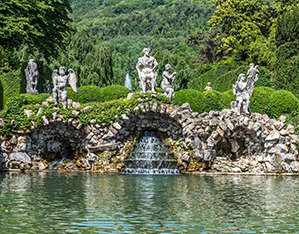
Water Features
The garden’s many fountains are named after a Swan, Stack and Dolphins; three fishponds are named after rivers (the Brenta and Bacchiglione), winds (Eolo and Deiopea, Borea and Zeffiro), and goldfish (from the 19th century). The water features that leap into life without warning are designed to surprise.
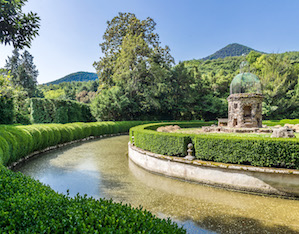
The “Rabbit Warren” or “Rabbit Island”
This short elliptical expanse of land surrounded by a ring of water with an aviary in the middle is one of the rare features to have survived the passage of time. A Renaissance version of the leporaria found in Ancient Roman gardens, the Rabbit Island once had the practical purpose of providing meat for the owners’ table.
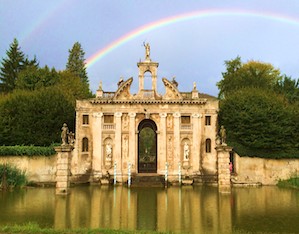
The Baths of Diana
Conceived as a triumphal arch providing access to the garden watched over by Diana the huntress, queen of the woods and the beasts, portrayed in the act of hurling a dart from her quiver, this was once the entrance to the property. It is well worth viewing from the outside, where the long east-west perspective towards the three fishponds is at its most impressive.
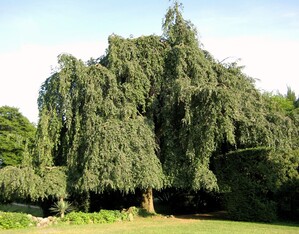
Heirloom Plants
Originally planted in the 19th century, the Chamaecyparis lawsoniana (or false cypress), Cryptomeria japonica (or red cedar of Japan), Cedrus Libanito the right of the entrance, and a Fagus sylvatica pendula (or hanging beech), by the Goldfish Tank, and the Calocedrus decurrens (or incense cedar) on the edge of the “warren”, are now of considerable size.
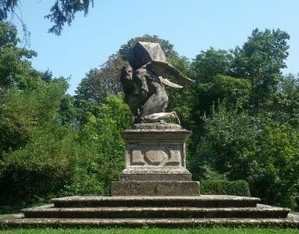
Garden statues
German artist Heinrich Meyring’s statue of Time is an old man carrying a heavy polyhedron on his shoulders, referring to the transience and difficulties of life. Many sculptures with matching inscriptions are female allegorical figures, for example Salubrity and Fertility, pagan gods or Christian virtues.
 Villa Barbarigo Pizzoni Ardemani
Contacts
Villa Barbarigo Pizzoni Ardemani
Contacts
Contacts
Telephone:- +39 340 0825844
- +39 049 9131065
- +39 049 9130042
Address
Via Diana, 2
35030, Valsanzibio (PD)
 Villa Barbarigo Pizzoni Ardemani
Opening times and prices
Villa Barbarigo Pizzoni Ardemani
Opening times and prices
Opening hours
Garden
- open every day from the last weekend in February to the second weekend in December, from 10.00 a.m. to 1.00 p.m. and from 2.00 p.m. to sunset (Saturdays, Sundays and public holidays all day long)
Labyrinth
- Saturdays, Sundays, holidays from 11.00 a.m. to 1.00 p.m. and from 2.30 p.m. to 60 minutes before closing time.
- Mondays and Fridays from 11 a.m. to 1 p.m. and from 2.30 p.m. until 60 minutes before closing time, but only on request at the ticket office/garden entrance.
Guided tours
- every Saturday, Sunday and holidays at 11 a.m. and 3.30 p.m. (4 p.m. – 4.30 p.m. from May to August).
Pricing
Single tickets
- Full price € 11,00
- Children/youth € 6,50
Groups
- Adult group (20+ people) € 9,00
- School groups (reservation required): € 6,50
Labyrinth
- Adults €4.00 (additional to the entrance fee)
- Children/youth up to 14 years old free of charge (must be accompanied by at least one adult)
 Villa Barbarigo Pizzoni Ardemani
How to get there
Villa Barbarigo Pizzoni Ardemani
How to get there
Address
Via Diana, 2
35030, Valsanzibio (PD)
Latitude: 45.292297
Longitude: 11.7267895
How to arrive by road
Motorway A13 Bologna-Padova exit Terme Euganee. Continue on Via Mincana/Strada Provinciale 9/SP9 as far as Valsanzibio.
 Villa Barbarigo Pizzoni Ardemani
Services/Accessibility
Villa Barbarigo Pizzoni Ardemani
Services/Accessibility
Services
Guided tours
- Guided tours start from the Garden ticket office, are not exclusive and any visitor to the garden can participate. Reservation is not required, but appreciated. Alternatively, we recommend arriving at least 15 minutes before the start. For information on the types of visits and relative costs, consult the website of the Villa.
- On the days and at the times of regular opening to the public, upon reservation and pre-payment by bank transfer (to guarantee the guided tour service, the reservation must be made at least 6 days in advance, if internal garden guides are requested, only in Italian or English; 30 days in advance, if external guides are requested, in all languages). For information consult the website.
Villa Barbarigo Pizzoni Ardemani offers the possibility to stay in its spaces. For information and reservations visit the website.
All dog owners are welcome at the Monumental Garden of Valsanzibio.
- By regulation, only small dogs (up to about 5/6 kg) can participate with their owners in the visit of the garden. Small dogs are allowed only in arms.
- Medium/large dogs must be left at the new Dogland Park 'Hospitality' for dogs while visiting the Garden. For more information consult the website of the property.
The restaurant is open on Saturdays and Sundays.
Arriving on the provincial road SP25 from the south-west, you will find the Villa's private car park, located on the left along Via Diana. Parking is private, free, but not guarded. The ticket office of the Garden is a few meters from the parking lot.
 Villa Barbarigo Pizzoni Ardemani
Private events
Villa Barbarigo Pizzoni Ardemani
Private events
Villa Barbarigo Pizzoni Ardemani offers its premises for events, advertising, music videos, filming, photography and commercial and/or private videos.
For further information consult the website of the
Villa
.
 Villa Barbarigo Pizzoni Ardemani
Itineraries
Villa Barbarigo Pizzoni Ardemani
Itineraries
You could find the garden in these itineraries
 Favorite saving result
Favorite saving result
 Warning!
Warning!
You've have to sign up or sign in to add this element to your favorites.
